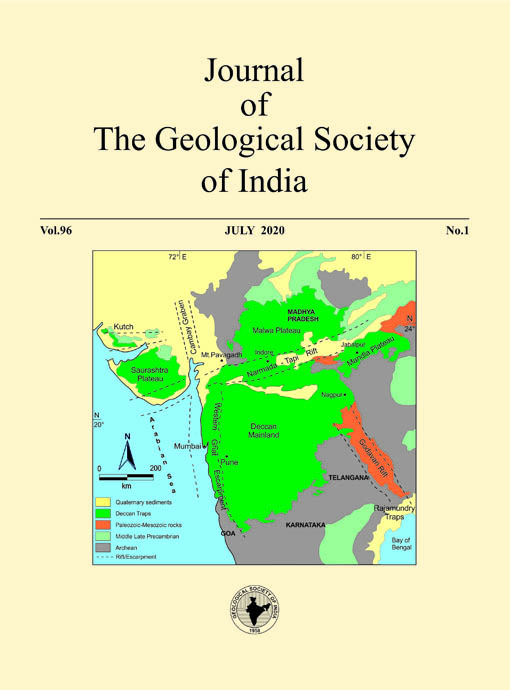Thermodynamic Modelling of Effect of Flux on the Liquidus Temperatures and Phase transitions in Coal Ash
DOI:
https://doi.org/10.1007/s12594-020-1508-yKeywords:
No Keywords.Abstract
Plant shutdowns due to the accumulation of ash materials in the boilers is a commonly practiced problem in thermal power sectors. Cleaning of ash products at regular intervals need to be necessary for maintaining the good furnace operation conditions. Use of slagging technology is the best practice for the removal of high temperature ash products, in which the melting temperature of ash is lowered by using the additive technology. In this paper, the properties of ash products formed during the combustion of low grade Indian coal were analyzed in terms of proximate and ash fusion temperature analysis. The effect of flux addition on the slagging behavior of Indian coal ash was analyzed. The AFT analysis of Indian origin coal ash shows that it is of non-fusible type. The formation of high temperature stable phases like kaolinite and quartz are the reason for high AFT temperatures in Indian origin coal.Downloads
Metrics
Issue
Section
Downloads
Published
How to Cite
References
Banerjee, A., Mishra, P. R., Mohanty, A., Chakravarty, K., Biswas, R. D., Sahu, R. and Chakravarty, S. (2016) Distribution of mineral species in different coal seams of Talcher coalfield and its transformation behavior at varying temperatures. Internat. Jour. Coal Sci. Tech., v.3(2), pp.97-103.
Bilen, M. (2019) Ash melting behaviour of some low-grade Turkish coals and some imported steam coals. Combustion Theory and Modelling, v.23(6), pp.1105-1118.
Chakravarty, S., Mohanty, A., Banerjee, A., Tripathy, R., Mandal, G. K., Basariya, M. R., & Sharma, M. (2015) Composition, mineral matter characteristics and ash fusion behavior of some Indian coals. Fuel, v.150, pp.96-101.
Han, J., Yu, D., Wu, J., Yu, X., Liu, F., Wang, J. and Xu, M. (2019) Fine Ash Formation and Slagging Deposition during Combustion of Silicon-Rich Biomasses and Their Blends with a Low-Rank Coal. Energy & Fuels, v.33(7), pp.5875-5882.
He, C., Bai, J., Ilyushechkin, A., Zhao, H., Kong, L., Li, H. and Li, W. (2019) Effect of chemical composition on the fusion behaviour of synthetic highiron coal ash. Fuel, v.253, pp.1465-1472.
Huang, Z., Li, Y., Lu, D., Zhou, Z., Wang, Z., Zhou, J. and Cen, K. (2013) Improvement of the coal ash slagging tendency by coal washing and additive blending with mullite generation. Energy & Fuels, v.27(4), pp.2049-2056.
Johnson, S. A., Wurster, J. and Comer, J. P. (2018) U.S. Patent No. 9,951,287. Washington, DC: U.S. Patent and Trademark Office.
Kim, J.H., Kim, G.B. and Jeon, C.H. (2017) Prediction of correlation between ash fusion temperature of ASTM and Thermo-Mechanical Analysis. Applied Thermal Engg., v.125, pp.1291-1299.
Kong, L., Bai, J., Bai, Z., Guo, Z. and Li, W. (2014) Improvement of ash flow properties of low-rank coal for entrained flow gasifier. Fuel, v.120, pp.122-129.
Lin, R., Lin, C., Li, Y. and Lin, B. (2019) Study on the synergistic effect of calcium and aluminum on improving ash fusion temperature of semicoke. Internat. Jour. Coal Preparation and Utilization, pp.1-9.
Mishra, P.R., Sahu, R. and Chakravarty, S. (2020) Viscosity Analysis of Indian Origin Coal by Using FactSage at Different Temperatures. Trans. Indian Institute of Metals, v.73(1), pp.207-214.
Neupane, B., Ju, Y., Silwal, B.R., Singh, P.K. and Huang, C. (2017). Structural investigations of Eocene coals from foreland basin of central Nepal Himalaya. Energy Exploration and Exploitation, v.35(6), pp.713-733.
Park, W. and Oh, M.S. (2008) Slagging of petroleum coke ash using Korean anthracites. Jour. Industrial Engg. Chemistry, v.14(3), pp.350-356.
Shepard Jr., R.N. and Rozelle, P.L. (2002) U.S. Patent No. 6,484,651. Washington, DC: U.S. Patent and Trademark Office.
Singh, A. K., Singh, P. K., Singh, M. P., & Banerjee, P. K. (2015) Utilization of the permian coal deposits of West Bokaro, India: A petrochemical evaluation. Energy Sources, Part A: Recovery, Utilization, and Environmental Effects, v.37(10), pp.1081-1088.
Vassilev, S. V., Kitano, K., Takeda, S. and Tsurue, T. (1995) Influence of mineral and chemical composition of coal ashes on their fusibility. Fuel Processing Tech., v.45(1), pp.27-51.
Wang, G., Jensen, P. A., Wu, H., Frandsen, F.J., Laxminarayan, Y., Sander, B. and Glarborg, P. (2019) KOH capture by coal fly ash. Fuel, v.242, pp.828-836.
Wu, C., Wang, B., Zheng, J. and Li, H. (2019) Flux mechanism of compound flux on ash and slag of coal with high ash melting temperature. Chinese Jour. Chemical Engg., v.27(5), pp.1200-1206.

 Naresh Kumar
Naresh Kumar






